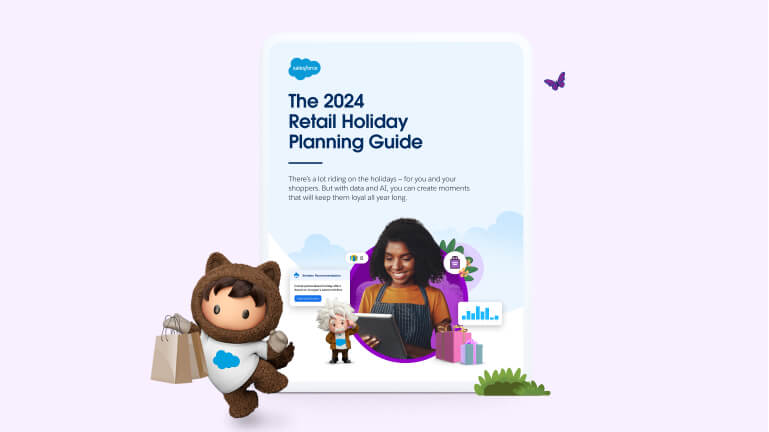Let’s Talk About Conversational Search (And Other Commerce Tips for the Holiday Season)



Conversational commerce is our top tactic for retailers who want to drive conversion this year.

Your customers value quick, easy, and convenient retail shopping experiences all year long but especially during peak shopping season. Even before they’re ready to buy, shoppers often start browsing with their fingertips, searching for deals and comparing prices.
This holiday season, digital channels will continue to grow in importance. More than half of revenue is expected to come from digital channels within the next two years. To stay competitive, you must wow your customers with frictionless shopping journeys that are intuitive, streamlined, and fast. When planning your retail holiday strategy, put your customers’ needs first and simplify the retail shopping experience.
Our sure-fire holiday commerce tips:
- Use generative artificial intelligence (AI) for conversational commerce.
- Keep online retail shopping experiences in the moment.
- Prioritize frictionless purchase and fulfillment.
- Simplify online returns.
Tip #1: Power conversational commerce with generative AI
Last year, we saw commerce teams use generative AI to transform the retail shopping experience. They offered product recommendations based on search history, responded to real-time customer questions with bots, and predicted product demand based on trends. In fact, 82% of commerce organizations that implemented AI saw moderate to major improvements in the customer experience.
Now, retailers can take the next step with generative AI. Conversational commerce, large language models, and natural language processing have changed the gift-giving game.
Conversational search lets online shoppers ask questions in the everyday language they would use if talking to an in-store associate. Rather than using defined commands, shoppers can enter (or ask) complete queries with detail and context. It’s a much better shopping experience because it results in more accurate and personalized responses and improves product discovery, increasing shopper satisfaction.
Retail Secrets for Holiday Season Success
Last year, 17% of orders in November and December were influenced by AI, totaling $199 billion in sales. In Cyber Week alone, seven days of online sales generated $51 billion worldwide through AI. Conversational search will be a major force this season. As retailers increasingly embed AI into search experiences, we predict a nearly 3x better conversion rate compared to traffic not engaging with site search this year.
(Return to top.)
Tip #2: Keep online retail shopping experiences in the moment
Staying ahead of the next big holiday can be a challenge. Flash sales, blowout events, and huge promotions drive new waves of online traffic to your website, app, and social media channels. When one peak moment is over, don’t confuse shoppers by letting it linger on your website days later. When deals aren’t refreshed instantly and consistently across all your customer touchpoints, it causes headaches for your staff and frustration for your customers.
How do the most efficient, effective teams keep their ecommerce websites updated with the most current messaging, products, and offers? With composable commerce. In just a few clicks, you can make changes to all of your digital channels, including mobile and social, automatically and simultaneously. You don’t even need to engage your developers. Best of all, shoppers will love that you’re meeting them at the right moment and reward you with their business. Leaders know the speed and agility gained through composable commerce gives their business a competitive edge — especially during the fast-moving holiday season. That’s why 46% of IT teams have implemented it, and 43% plan to.
Additionally, when this architecture is integrated with your social channels, you can serve up dynamic product ads and offer in-app checkout. These surprise shopping opportunities encourage purchases by consumers who weren’t actively browsing but were intrigued by a product spied in a social post.
(Return to top.)
Tip #3: Prioritize frictionless purchase and fulfillment
Everyone is in a hurry, but never more so than during the holiday shopping season. Whether online or in-store, customers want to quickly find, pay, and bring home their treasures as soon as possible. Encourage customers to make that final “click” by upgrading your payment and fulfillment options with an eye on flexibility and convenience. Make it easy to shop by upgrading:
- Payments: Just as tap-and-go credit cards have become the norm in the store, don’t overlook one-click online payments and high-growth payment options like mobile wallets, Buy Now Pay Later (BNPL), and Pay Over Time (POT).
- Store fulfillment: Enable flexible fulfillment options, like buy-online-pick-up-in-store (BOPIS), a choice that’s popular with customers and that’s been adopted by 85% of retailers.
- Try-at-home services: Some retailers are experimenting with temporary try-at-home options that let customers use products for a few days without charge.
- Notice of out-of-stocks and slow delivery: Don’t disappoint buyers by revealing the gift they need for next week’s party is out of stock after they’ve completed their online purchase. Note shipping delays on the product page and suggest a comparable product as a replacement.
- Make it easy for customers to track purchases: Be sure they can access their order history, track delivery, and use self-service to arrange a return or exchange.
(Return to top.)
Tip #4: Simplify online returns
Don’t let messy returns ruin the retail shopping experience. Merchandise returns cost retailers $743 billion in 2023, with nearly 14.5% of purchases heading back to stores and warehouses. If you’re considering scaling back return policies by shrinking the return window, establishing final sales, or charging restocking fees, first consider the impact it could have on customer loyalty. For many customers, the return and exchange policy is the top reason they choose a retailer. Even more important, 95% of customers say a bad returns experience makes them less likely to buy from a brand again.
You don’t have to risk customer satisfaction to preserve margins. It’s possible to streamline returns for customers, retain revenue, and save on costs:
- Automate returns: Let customers generate their own return authorization codes and labels, and make shipping free — an experience preferred by 64% of shoppers, according to our research. Additionally, you’ll reduce service worker caseload and lower cost to serve.
- Enhance product detail pages: Make sure your product pages provide detailed descriptions. We found 46% of consumers relied on customer reviews when choosing the correct size and color, followed by user-generated photos and sizing charts, all of which reduced the volume of returns.
- Encourage exchanges, not returns: When a customer requests a return online, offer personalized product recommendations to replace the initial purchase. We see 88% of consumers prefer an exchange to a return at least some of the time.
- Collect returns from a centralized location: Allow customers to drop returns at a central location managed by a third-party returns provider, like what Amazon does at Whole Foods and Kohl’s. It’s convenient for customers and helps you save on costs since you can bulk-ship packages back to the warehouse.
- Enable instant refunds: Our research found 46% of customers think instant refunds make returns easier. As soon as your employee scans the return shipping label, issue the refund.
(Return to top.)
Easy retail shopping experiences keep customers loyal
As shoppers go mobile, commerce teams need to get agile and offer simplified digital touchpoints and flexible purchase, fulfillment, returns, and service options. Make peak shopping moments more convenient by using real-time data, AI, and automation to deliver connected, consistent, and simplified retail shopping experiences.
(Return to top.)




























